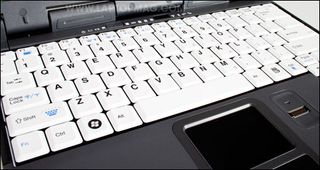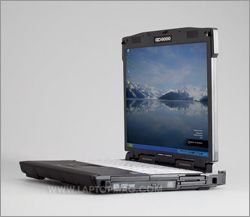Laptop Mag Verdict
This rugged notebook gives mobile workers all the protection they need.
Pros
- +
Built to withstand drops, dust, and spills
- +
Daylight-viewable touchscreen display
- +
Embedded lights can illuminate keyboard
- +
Surprisingly light for rugged notebook
- +
Strong performance
Cons
- -
Relatively low-resolution screen
- -
24/7 tech support costs extra
Why you can trust Laptop Mag
When is rugged too rugged? General Dynamics Itronix realized that a majority of fully-rugged notebooks were rarely being taken out of vehicles--and customers were paying for protection they didn't need. That's why the company has a "vehicle-rugged notebook," the GD6000. This notebook can withstand the rigors of being in a car, including vibration, drops, dust, and the occasional coffee spill. $3,545 may seem like a steep price point, but the premium is worth it for those who want their investment to last beyond the three-year warranty.
Design
From the outside, the GD6000 looks like a fully rugged notebook, and bears more than a passing resemblance to the GD8000. The entire system is gray and black, with the exception of the keyboard, which has black type on white buttons. The GD6000 is not going to win any style points--the Dell Latitude E6400 XFR has more of a "rugged chic" look--but neither is it going to shatter any mirrors, unless you throw it at one.
At 10.2 x 12.1 x 2.2 inches and weighing 6.2 pounds, this isn't a notebook you're going to tote around much, but a metal handle and rubberized grip running along its spine makes carrying the system easier. The fully rugged 14-inch Dell E6400 XFR weighs 9.0 pounds, while the semi-rugged Panasonic Toughbook 74 weighs 6.0 pounds.
Heat
As its more spacious chassis undoubtedly allows for greater air circulation, the GD6000 stayed very cool during our tests. After playing a Hulu video at full screen for 15 minutes, the temperature of the touchpad reached 83 degrees Fahrenheit, the space between the G and H keys was 86 degrees, and the middle of the underside measured 95 degrees. We consider anything greater than 100 degrees to be uncomfortable.
Keyboard and Touchpad
As mentioned above, the keyboard on the GD6000 is white with black lettering; this makes the keys easy to see in dimly lit environments, even without backlighting. However, for those times then it's too dark, two lights embedded in the display hinge provide more than enough illumination, even in a pitch-black room. The keys themselves were a little shallow when it came to travel, but they were comfortable and responsive to type on.
Considering the size of the deck, the 2.3 x 1.6-inch touchpad was on the small side, but it offered smooth operation. The two mouse buttons below were nice and snappy, but you can only press them toward the outer half.

Click to enlarge
Display and Audio
The GD6000 uses a 13.3-inch, 1024 x 768-pixel touchscreen. That resolution is on the low side, but we like the 500-nit brightness, which is paired with General Dynamics' DynaVue technology to make the panel easily viewable in sunlight. The display sports a traditional 16:10 aspect ratio, which provides more vertical real estate to fit more information on the screen.
We could only tilt the display back about 28 degrees before the image started to degrade. Horizontal viewing angles were much better; people sitting on either side of the system could see the screen easily. However, the coating kicks back plenty of reflections in brightly-lit areas.
The GD6000's resistive touchscreen can be used with either your finger or the included stylus, which is a nice feature. The glossy screen created too much friction when using our finger; we had to press firmly for the display to recongize any of our movements. When we did get it to work, though, the GD6000 was responsive as we spun the globe in Google Earth. The screen does not support more than one finger input at a time, so multitouch gestures are out.
Two integrated stereo speakers above the display were decently loud; while this isn't an entertainment system, we were also impressed with their fidelity when listening to music or watching movies.
Ports
With the exception of the headphone jack, mic input, and a Kensington lock slot on the left side, all of the GD6000's ports are on the back: VGA, Ethernet, modem, two USB 2.0, and a serial port. These are covered by rubber seals to protect them against the elements, but accessing them is made difficult not only by their placement on the rear, but also by the carrying handle. The right side of the notebook has an ExpressCard/54 slot, PC Card slot, and the optical drive. Unlike a fully rugged system, such as the Dell E6400 XFR, the ports and slots are not protected by hinged covers.
The GD6000 does not come with a webcam.
Rugged and Security Features

Click to enlargeIn many ways, the GD6000 is just like a fully rugged notebook. The chassis and bottom of the unit are made out of magnesium, as are the lid and palm rest; the latter two are covered with plastic, which not only makes for a better looking system, but also helps keep the notebook cool.
This laptop meets MIL-STD 810F military rugged requirements for temperature (-22 to 145 degrees Fahrenheit), vibration, dust ingress, and humidity. The two areas in which it's somewhat less rugged are drop resistance (the GD6000 can withstand 6 drops from 30 inches) and water resistance (it can be soaked with up to 400 cc's of water for 10 minutes). Fully rugged notebooks, by comparison, can be dropped from heights of up to 48 inches and, due to their sealed ports, can withstand water blown at them from all angles.
In order to test these claims, we dropped the GD6000 6 times from 30 inches, and it booted up with no problems. However, on the last drop, the DVD drive sprang open. With the laptop on, we then poured 8 ounces of water on the keyboard and deck; while most of the water sloughed off the system, an ounce or two remained in the keyboard and the touchpad. After letting it sit for 10 minutes, we then poured the remaining water off and dried the notebook. All the while, the GD6000 performed normally.
Of course, you need to protect your laptop from more than just the elements, and in that regard the GD6000 comes fully loaded. You get standard TPM 1.2 network security, a fingerprint reader, CAC (Smart Card) reader, removable hard drive, Kensington lock slot, and super password startup configurations.
Performance
The GD6000's 2.53-GHz Intel Core 2 Duo T9400 processor and relatively meager 1GB of RAM (expandable to 4GB) combined to give the system a PCMark05 score of 4,631. That score is about 700 points higher than the GD8000, which has a slower 1.86-GHz Intel Core 2 Duo SL9400 processor and 2GB of RAM.
In everyday tasks (as well as our other benchmarks), the processor had plenty of power: it converted a 114MB MPEG-4 file to AVI using HandBrake in 5 minutes and 24 seconds, which is 1:20 faster than the mainstream notebook category average, but nearly twice as long as some of the new Core i7 systems, such as the Sony VAIO F series. When performing the same task using Oxelon Media Converter, which takes advantage of a notebook's multiple cores, the GD6000 finished in just 54 seconds, which is very speedy indeed. The ASUS K42F, which has a 2.53-GHz Intel Core i5-540M CPU, took 51 seconds on the same test.
We don't even see Windows XP on netbooks that much anymore, but the GD6000's 120GB hard drive booted the OS in 52 seconds, 7 seconds faster than average. However, when it came to copying a 4.97GB folder of multimedia, this rugged machine was on the slow side, averaging a transfer rate of 17.0 MBps.
The GD6000 clearly isn't a graphics-oriented notebook, so we weren't surprised when its integrated Intel GMA 4500 GPU turned in a 3DMark06 score of just 807, nearly 700 points shy of the thin-and-light category average (and 2,354 less than the average mainstream notebook). Still, this was the same score as that achieved by the Dell Inspiron 14z. Gaming tests produced predictably feeble scores: with the resolution set to 1024 x 768 and effects on default, the GD6000 averaged just 24 frames per second in World of Warcraft. With the effects maxed out, that number dropped to 7 fps.
Battery Life and Connectivity
The six-cell battery in the GD6000 lasted 3 hours and 37 minutes, just 6 minutes longer than the mainstream average, and about half an hour longer than the Dell Latitude E6400 XFR. We'd hope for more, but since this system is designed to remain plugged in most of the time, this lack of endurance isn't troubling.
The GD6000's 802.11a/b/g/n Wi-Fi scores were about in line with the mainstream averages. At 15 feet from our access point, the laptop delivered throughput of 20.7 Mbps; at 50 feet, the throughput dropped to 18.0 Mbps. In addition to Wi-Fi, the GD6000 is available with EV-DO Rev. A and HSPA wireless broadband. The notebook also has a SIRFstar III GPS module (although our review unit was not preloaded with GPS software) and Bluetooth 2.0 + EDR.
Green Testing

Click to enlargeThe GD6000 took 1 hour and 5 minutes to charge its battery to 80 percent, and another 46 minutes to completely recharge. During that time, the notebook drew an average of 52.9 watts. Its LAPTOP Battery Efficiency Rating (total watts divided by the battery life) of 27.1 is well below the mainstream average of 44.4, and more on a par with thin-and-light notebooks (26.1). Lower scores are better.
Configurations and Warranty
As the GD6000 is designed for enterprise users, there are plenty of customization options, including a solid state hard drive, a hard drive heater, Smart Card reader, up to 4GB of RAM, a nine-cell battery pack, and various software bundles. Pricing depends on the number of units ordered.
The GD6000 comes with a three-year limited parts-and-labor warranty and 8 a.m. to 8 p.m. (Monday through Friday) tech support. Customers can upgrade to 24/7 tech support with an agent assigned to their individual accounts, but the price varies on a client-by-client basis.
Verdict
When you're driving around all day in a vehicle, having a fully rugged notebook is overkill, but a business rugged system won't cut it, either. At $3,545, the GD Itronix GD6000 is just right, costing about $700 less than the GD8000, a fully rugged system with lower performance numbers. While notebooks such as the $5,137 Dell Latitude E6400 XFR are best for those working in the most extreme of environmental conditions, the GD6000 offers a good mix of protection and portability for a reasonable price.
GD Itronix GD6000 Specs
| Bluetooth | Bluetooth 2.0 EDR |
| Brand | General Dynamics |
| CPU | 2.53-GHz Intel Core 2 Duo T9400 |
| Card Slots | ExpressCard/54, PC Card |
| Company Website | http://www.gd-itronix.com |
| Display Size | 13.3 |
| Graphics Card | Intel GMA 4500 MHD |
| Hard Drive Size | 120GB |
| Hard Drive Speed | 5,400rpm |
| Hard Drive Type | SATA Hard Drive |
| Mobile Broadband | EV-DO Rev. A & HSDPA |
| Native Resolution | 1024x768 |
| Operating System | MS Windows XP Pro |
| Optical Drive | DVD-RW |
| Ports (excluding USB) | Kensington Lock, Headphone, Ethernet, serial, VGA, Modem, Microphone |
| RAM | 1GB |
| RAM Upgradable to | 4GB |
| Size | 10.2 x 12.1 x 2.2 inches |
| USB Ports | 2 |
| Video Memory | Shared |
| Warranty/Support | Three-year limited parts-and-labor/Mon--Fri 8 a.m. to 8 p.m. (EST) toll-free |
| Weight | 6.2 pounds |
| Wi-Fi | 802.11a/b/g/n |
